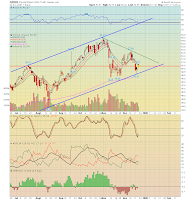2007 was a great year for my trading & investing account. It was a transformational year where I was able to identify my weak points and capitalize on my strong points.
Listed below are key items that contributed to my success. I hope this will be a useful guide to my other fellow traders as we navigate the stock market through 2008 and beyond.
* Very disciplined trading. No hopes and emotions. Losses were sold immediately without a second thought.
* Accurate and complete trading records with comments for each trade. The comment provided the reason for the purchase.
* Month-end summaries, where I had to provide the monthly performance -monthly gain/loss to my better half. Helps as you are answerable to someone and you would ensure that you complete the month on a gain. I also tried improving on my monthly gain each month.
*Strict money management principles. In the beginning of the year, based on the portfolio size, I determine the amount of loss that I can take in any stock. Then, before I buy a stock, I enter the following three details in excel: Buy price, Sell price and Stop price. Based on the stop price, and the amount of loss I can bear in a stock, the excel file calculates the number of shares of the stock I can purchase. So, the further away the Buy price is from the stop price, the lesser the number of shares I purchase.
*Strengthened my TA skills , learnt Elliott Wave theory from a great trader whom I truly respect. I believe his classes on TA and learning to count waves have set me apart from other TA traders. He goes by the alias name BT or BlackTruck and his email is black.truck@verizon.net. Please send him an email if you are interested in joining his class.
*Read and implemented the 2% Shark rule and 6% Piranha rule mentioned in Dr. Alexander Elder's Come into my trading room. This is an amazing book. I read this book in October 2006 and since then I have been able to view the stock market in a very different angle.
* Last but not the least, starting this blog and sharing my thoughts with all of you have helped me to streamline my thoughts and identify trends. If I have learnt something that makes a big difference, I strongly believe in sharing those thoughts and helping others.
Goldman on Shelter Inflation
9 hours ago





